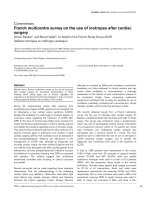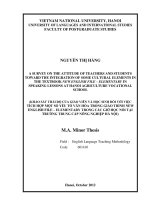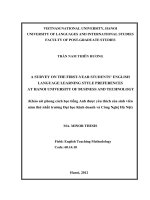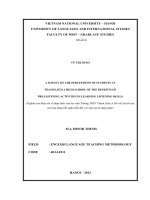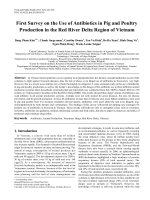Survey on the blockchain security
Bạn đang xem bản rút gọn của tài liệu. Xem và tải ngay bản đầy đủ của tài liệu tại đây (107.47 KB, 10 trang )
1.
Area name : New Trend
Title : Survey on the blockchain security
3. Purpose of study(under five lines)
The purpose of the study is to help understand the history and development of
blockchain security technology and its popularity. From there, it can help guide the
development of blockchain technology in which specific areas
4. Scope of survey(list up the scope of the searching by items)
Blockchain là gì?
5.1 What is Blockchain
5.2 Versions of blockchain
5.3 Block structure
5.4 Hash function in blockchain
5.5 Consensus algorithms
5.6 Applications of blockchain
5. Results of the study
5.1 What is Blockchain ?
A blockchain is a series of blocks that are linked together and contain
data. This database is shared on a network of computers (called a distributed
ledger network). A cryptographic hash of the preceding block, a timestamp,
and transaction information are used by each data block in the blockchain to
link it to earlier blocks. Blockchain technology is built to withstand data
chane. The blockchain contains unchangeable data that can only be added to
with the support of all other nodes. Other computers and nodes will keep
working and preserving data even if a portion of the blockchain system
crashes. Blockchain in particular allows data to be transmitted without the
need for a middleman to verify the information. The blockchain system is
made up of numerous autonomous nodes that may validate data without the
need for a "sign of trust."
5.2 Versions of blockchain
5.2.1 Blockchain 1.0 ( Cryptocurrency)
1 |Page
Hall Finley, who invented DLT (Distributed Ledger Technology), the
first program based on bitcoin, initially announced blockchain in 2005. The
most notable example in this section is bitcoin.
5.2.2 Blockchain 2.0 ( Smart Contract)
Smart Contracts, computer programs that "live" in the blockchain
chain. They are free computer programs that execute automatically and check
for predefined conditions like support, verification. Used as an alternative to
traditional contracts
5.2.3 Blockchain 3.0 ( Dapps)
After version 2.0, the new version introduced includes Dapps known
as Decentralized Apps. It has backend code that runs on a peer-to-peer
network. Dapp can have example code of Blockchain frontend and UI written
in any language that can call to its backend, just like traditional application.
5.2.4 Blockchain 4.0 ( Blockchain for industry)
The goal of blockchain 4.0 is to solve the whole problem of the
previous three generations. It explains strategies and methods to make
blockchain technology ready for business needs. Businesses are ready to adopt
blockchain technology, but we need a more secure and robust blockchain.
5.3 Block structure
The first block of a blockchain is called the “Genesis Block”, and it is used as
the basis for the entire chain, as shown in Figure 1.
Each block in the blockchain consists of the following components as shown
in Figure 2 [1] :
+ Data: Information stored in the block
+ Hash ( Current and Previous): function that takes an input of any
length and produces a unique fixed length output. If a single value in the input is
modified, the output will be wildly different.
2 |Page
+ Timestamp: record the moment the block was create. A approach for
securely tracking a document's creation or modification time is the use of timestamps.
+ Other information: contains digital signatures, nonce values, nBits
and a few other user defined values. Every user has two keys, a private and public key.
A digital signature containing these two keys is involved in both signing phase and
verification phase. The private key is kept confidential and is used to sign a
transaction to encrypt the data. The public key is known by everyone and is used to
validate and decrypt the data in the verification phase of the transaction,
consequentially confirming data authenticity.
5.4 Hash function in blockchain
5.4.1. What is a hash function?
-. Hashing is the process of turning the input into a content of any size
and length and then using algorithms and mathematical formulas to turn it into a
standard output of a certain length. That process uses Hash Functions.
5.4.2. Cryptographic hash function
-. A cryptographic hash function is a hash function with certain
security properties that makes it suitable for use in a wide variety of information
security applications, such as authentication and integrity checking of input data. It's a
hash function that takes an arbitrary length string as input and produces a fixed length
string as a result.
And for a hash function to be considered a cryptographic hash function, it needs to
meet at least the following 5 criteria [2]:
3 |Page
+ Deterministic: this means that when you input data and pass it through the
hash function, you will always get the same output string. This is a necessary criterion
because if for each run through the hash function we get a different output then it
would be impossible for us to keep track of the input value.
+ Quick Computation: hash function has the ability to return at the fastest
possible rate. Because in reality, the input data is not a string, or an int, but can be a
very large image file and we need to run a hash function for each input. So if the
hashing process is slow, the system won't be able to perform at its best.
+ Pre-image resistance: is a property of a hash function that is hard to reversedirect, i.e. for an element within the range of a hash function, it is computationally
infeasible to find the input that maps to that element. Simply put, if a hash function x
produces a hash value of y, it will be difficult to find the input value z that hashes to y.
This property protects against a hash-only attacker trying to find input.
+ Small changes in the input changes the hash: as soon as you make a small
change in the input, the changes will be reflected in a very large hash. Test it with
SHA-256:
INPUT
HASH
Test
a5dadf18545f26484dd82e338dff4b25497c3fbe1c3c5a5408367b3896497fa
d
teST
cee8fda08920456db1ac811bef6222da4468bd3d73e7e840353e2c97d0cec2
96
Even changing a lowercase to uppercase has a huge impact on the output hash.
This is an important function because the hash property leads to one of blockchain's
greatest qualities, its immutability.
+ Collision Resistant: that is, in case we have 2 inputs, A and B, with hash
function A and hash function B respectively. It will be very difficult for the output
value of two hash functions to be the same. This property is called a collision-free
hash. Since the hash function is a compression function with a fixed hash length, it is
not possible to have hash function has no conflicts. This collisionless property only
confirms that the collision makes it difficult to find.
4 |Page
5.5. Consensus algorithms
It can be said that the heart of the blockchain is the consensus algorithm. Consensus
algorithms are known as a procedure by which peers of a blockchain network reach a
general agreement about the current state of the distributed number. Thus, consensus
algorithms achieve trust in the blockchain network and establish trust between
unknown peers in a distributed computing environment. Basically, the consensus
algorithm ensures that the new block added to the blockchain must be the only version
agreed upon by all the nodes in the blockchain. Therefore, a consensus algorithm aims
to find a common agreement that benefits the entire network. We will look at several
different consensus algorithms[3] and their advantages and disadvantages:
+ Proof of Work ( PoW): this consensus is used to select a miner for the next
generation of blocks. Participants need to solve complex math problems in order to
add a block to the blockchain. The purpose of this is that users have to use their own
resources to be able to validate data into the blockchain. Bitcoin uses this PoW
consensus algorithm, Bitcoin will be safe as long as there are more than 50% honest
miners in the network.
. Advantages:
+ Good performance from 2009 to present
. Disadvantage:
+ Slow, takes a lot of energy
+ Practical Byzantine Fault Tolerance (pBFT): This protocol is still in use in
the form of the Hyperledger Fabric blockchain. pBFT is efficient with a small network
of members participating in the consensus process. Preferably less than 20 members.
pBFT focuses on providing state machine replication, which is tolerant of Byzantine
failures (malicious nodes). The algorithm is designed to work in asynchronous
systems and is optimized for high performance..
. Advantages:
+ Transaction throughput can be up to hundreds of thousands
of transactions a day
. Disadvantage:
+ Only suitable for licensed or private blockchains
+ Proof of Stake (PoS): This is a popular alternative to PoW. In this type of
algorithm, instead of investing expensive hardware to solve complex puzzles,
validators invest in system coins by locking up some of their coins as convenience
bets. Then the validators will start validating blocks. Validators will confirm blocks by
5 |Page
staking on it if they discover a block they think can be added to the chain. Based on
the actual block nca1c added in the Blockchain, all validators will receive rewards
corresponding to their bets and their stakes increase accordingly. Finally, validators
are chosen to generate a new block based on their economic stake in the network.
Therefore, PoS incentivizes validators through an incentive mechanism to reach
agreement.
. Advantages:
+ Save energy
+ It costs more to attack
. Disadvantage:
+ nothing-at-stake problem ( problem refers to the fact that
block creators on generic PoS protocols do not have anything at stake when the
network forks)
+ Delegated Proof Of Stale (DPOS): is a consensus mechanism used in EOS
(blockchain platform and Smart Contract). In DPOS the stakeholders elect witnesses
to mine the block on their behalf. This process will be slightly faster than PoS. For
example with EOS, the system will consist of 21 people who will be selected as
witnesses and will always keep that number so if one person tries to cheat or has
problems, someone else will immediately replace it. These witnesses will also be paid
in block generation. DPOS, miners do not have to compete with each other like PoW
or PoS so the speed will be much faster
. Advantages:
+ Energy saving, fast
. Disadvantage:
+ Focus
+ Participants who stake a lot can vote themselves to become
validators
5.6 Practical applications of Blockchain in life
Blockchain is becoming a trend in the current technology era, it contributes to
many areas for society [4]
5.6.1 Communication and telecommunications
Deploying blockchain solutions on the cloud will help communication service
providers optimize existing processes while enhancing network security,
reviewing the entire operating process, processes like roaming and identity
6 |Page
management in its business model. From there, improve and develop better
services.
5.5.2 Products
In the production process, we need a ledger to track the production process,
inventory, distribution, quality, transaction information ... Blockchain will
replace smart devices that grant advanced management rights. efficiency and
significantly increase the productivity of process supply chain management.
For consumers, checking the authenticity of product information can prevent
fake and poor quality goods on the market.
5.5.3 Medical
Blockchain is used in asset management and patient health information
storage, inventory management, orders, medical device and drug payments.
Although there are many smart devices that can monitor these services, there
are still many limitations to the privacy of patients' personal information.
5.5.4 Education
When Blockchain is applied to education, the information stored on
Blockchain is not only transcript data but also the training process, practical
experience and recruitment experience of each person. Avoid candidates
cheating in the process of applying for scholarships, promotions, etc.;
misrepresentation of education, work experience, discipline, etc.
5.5.5 Banking and Finance
Due to the characteristics of the banking and finance industry, it is easy to
have a centralized state of power, infringing on user data security, so with
current Blockchain technology, these problems will be easily solved. Thanks
to the smart contract function, it can bypass intermediaries, save costs, speed
up transactions, limit financial risks in the payment process, and improve the
public information management system. old technology.
5.5.6 Reatil
7 |Page
The most difficult problem for retailers is the process of goods distribution,
warehousing as well as managing bulk product information. Blockchain is
applied as a ledger to record accurate information with high security. It allows
to manage records of each item, its location, how to handle, any damage
during distribution, thereby effectively supporting retailers.
5.5.7 Ecommerce
According to experts, the current retail market is gradually shifting to online
commerce, especially with the development of e-commerce platforms. This shift poses
problems in terms of security, supply chain management, the process of transporting
goods to consumers, costs from traditional ways, creating many barriers between
consumers and manufacturers. .
5.5.8 Agriculture
Food chains need to become more sustainable to enhance consumer trust and loyalty,
and the key to enhancing trust is effective traceability. A distributed ledger system will
help retailers and consumers store transaction information, and increase the
transparency of information throughout the product process from production facility to
processing facility. Distributors, supermarkets, retailers and ultimately consumers.
5.5.9 Travel
Customer information is converted from many systems from selecting agents, booking
bus tickets, booking hotels to visiting places, thus requiring high stability and security.
Besides, transaction costs are also a factor to be considered in the process of
exploiting this smokeless service industry. Blockchain participates in solving the
above problems, replacing the traditional management system with many problems
and errors.
5.5.10 Transport and logistics
During the life cycle of a product, through each step in the supply chain, data is
generated and recorded as transactions, creating a permanent history for the product.
Blockchain is the tool to manage that huge data warehouse. Blockchain can help
increase efficiency in sharing information about the production, transportation,
storage, and depreciation of products to stakeholders. Solve challenging problems in
logistics such as delays in delivery, loss of papers, documents, documents, unclear
product origin, and other errors in the transfer process between members in the
8 |Page
process. chain of logistics activities.
6. Problems and Solutions
6.1 Problems
Blockchain technology has shown great potential, helping traditional industries
transform to develop with Industry 4.0 and bring with them features such as:
decentralization, immutability, decentralization, transparent. It is thanks to these
characteristics that Blockchain-based frameworks are very interested and applied by
the community in many fields such as finance and banking, economy, socio-political,
health, education, legal smart co...
Transaction speed:
+ The unsolved problem of sluggish transaction speed is emerging as a major
challenge in blockchain adoption for practical applications. Due to the decentralized
nature of blockchain, each transaction must be verified by the nodes before it's
accepted as a block. In centralized systems, trust is put in a central governing body
(government or bank), which allows them to process millions of transactions per day.
+ For comparison, consider Bitcoin's transaction speed with businesses like
Visa. Right now, Bitcoin can only guarantee 4.6 transactions per second. Visa, on the
other hand, handles around 1,736 transactions per second on average (calculations
based on the official claim of 150 million transactions per day).
6.2 Solutions
In my opinion, the blockchain model should be more popular and applied in more
fields to help the fields have fairness and rigor.
An optimal solution is required to apply blockchain to banking transactions
7. References
[1]
Joshi, A. P., Han, M., & Wang, Y. (2018). A survey on security an
[2]
( last visited 2/1
9 |Page
[3]
/>
[4]
/>
10 | P a g e

